- We’ve recently discussed how to manage water within the context of Sustainable Intensive Agriculture.
- We now consider another precious resource – the soil itself.
- This discussion does not relate to individual farm practices, but to macro scale management.
Sustainable Soil
It doesn’t matter how carefully we manage the agricultural water supply, if the soil in SIA is not capable of delivering improved yields on a rolling basis, we have failed in our responsibilities to future generations.
Although we’ve discussed soil in the context of areas such as greenhouse gas emissions and efficient use of fertilizer, global warming makes soil management considerably harder.
A more extreme climate not only causes parched soils but also inundated ones. At the time of writing, in the world’s newest country, South Sudan, which many would associate with repetitive droughts and famine, there are 700,000 displaced persons desperately seeking higher ground after a very wet rainy season.
An Issue We Can Address
We’ve previously explained in depth the many roles SIA can play in reducing global warming but when we come to global soil management the issues are complex.
Here, we consider desertification. There’s no definitive answer as to the cause of this increasing problem but climate change, deforestation and overgrazing by livestock are certainly in the mix.
As defined by the UN using its aridity index (less than 0.65), 47% of the world’s land surface is considered dryland. It’s easy to conjure up images of the Sahara and it’s true that Africa has more than 65% of global drylands.

Less known is that Europe, particularly Southern Europe, has 24% of the area and that significant areas in Australia, Argentina and the US come into this category.
The solutions are going to be different depending on the level of aridity. We discussed some in the previous Insight, such as a combination of better rainfed and irrigated systems, as well as improved farming methods, including more appropriate soil management for semi-arid conditions.
Once we get into the extreme drylands (UN classification arid and hyper arid), different solutions are required. Although we’ve argued that, in SIA, expanding the acreage to increase production is not desirable, especially if deforestation occurs, extreme drylands are a notable exception. Some sustainable production is better than none at all. The re-introduction of vegetation is also desirable for the prevention of sandstorms. These storms can pollute blue water and bury re-vegetation efforts.
Preventing Desert Creep
This effort is focused on providing stable and non-windblown soil, which will benefit farmers away from the desert, mostly on the windward side. Typical methods include planting drought hardy trees, particularly acacia and eucalyptus, and erecting windbreaks.

It’s also why governments need to be involved as there may be no perceived immediate advantage to farmers, and they may not be able to visualise the final benefit.
Case Study 1: The Great Green Wall (China)
China has every reason to be interested in this issue, faced with the most actively creeping desert in the world, the Gobi, with 2500 km2 of topsoil displaced annually each year from dust storms.
There is an estimated 400 million people affected by desertification in China. Having started in 1978, the project has a completion date of 2050 and, already, more than 66 billion of an intended 100 billion trees have been planted along the ‘wall’ at the edge of the desert.

The Green Wall project is a multi-stage programme, which will eventually raise the forest area from 5% to 15% in Northern China, with the trees binding the soil and producing an invaluable carbon sink. The farmers of Inner Mongolia will be able to continue their lifestyle of grazing and planting maize (corn).
It’s also challenging as the trees must not exceed the moisture availability and wither and die. Farmers are offered incentives to plant trees as part of this program.
Re-Conquering the Desert
This is where there’s a saleable end-product from dryland remediation.
Case Study 2: Sundrop Farms (Australia)
In terms of SIA, we must commend this company for its innovation. In this case, the farming operation, established near Adelaide in 2015, does not use any soil, although it occupies an area of land in an arid scrubland.
Sundrop started with 40 hectares of tomatoes in glasshouses, using hydroponics (in water, not soil). An integrated system supplies solar energy using sun-tracking parabolic mirrors, fresh water, and electricity. The water source is seawater, which is desalinated. At one stage, there was a plan to also use the residual brine to create salt, but that’s been shelved for now and the water is returned to the Spencer Gulf. By the following year, the farm was able to produce 15k tonnes, or 10-15% of Australia’s truss tomatoes. They were initially marketed through Coles supermarket but, in 2019, they were acquired by Morrisons. It’s a remarkable success story.

Case Study 3: Salicornia (Multiple Countries)
Salicornia is a salt-loving plant that’s currently generating significant interest for commercial production in coastal drylands in several countries such as Mexico, Saudi Arabia, and Egypt.
Approximately 30% of the biomass is oil. It’s grown in seawater and is suitable for inclusions in animal feed (not as 100% pure fodder), and also for human consumption where chefs often call it ‘samphire’ or ‘sea asparagus’.

It’s currently also being used as a powder to replace table salt with a healthier low sodium alternative. However, its biggest impact is in fuel production at present, where it can produce around 950 litres of biodiesel per hectare. Salicornia requires nitrogen and, from an SIA viewpoint, the use of marine effluent from nearby aquaculture, especially from shrimp farming, is advised rather than artificial nitrogen.
Final Thoughts
With dryland farming, preserving useable land by ‘greening’ the desert and/or using available natural resources to create new production in uninhabitable areas is probably the best approach from an SIA perspective.
Other Insights That May Be of Interest…
Indian Ethanol: Triggering a Sugar Bull Market?
World Sugar Market Five-Year Forecast
